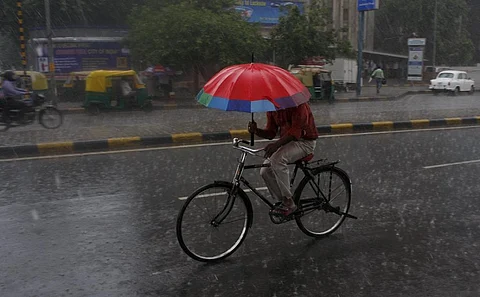

India has a new rainfall normal figure, according to which the normal mean rainfall during the crucial southwest monsoon season of June-September has decreased by 12 mm for the country.
The India Meteorological Department (IMD) April 14, in its forecast for the 2022 southwest monsoon rainfall, announced that the newly introduced new rainfall normal figure of 868.6 mm is based on 1971-2020 data.
It replaces the earlier normal of 880.6 mm based on the data of 1961-2010, the IMD said.
This essentially means that while the rainfall according to the new figures would be termed as ‘normal’, the country would experience less rainfall during the southwest monsoon than what it used to be a decade ago.
The southwest monsoon contributes 74.9 per cent to the annual rainfall in India and irrigates over half of India’s agricultural land. The quantity of rainfall or its failure directly impacts India’s agriculture, especially the kharif crop season which is heavily dependent on the monsoon.
Moreover, the new all India annual rainfall has also decreased by 16.18 mm for the country to 1,160.1 mm, from the earlier normal of 1,176.9 mm.
The IMD termed this decrease as a part of a natural “multi-decadal epochal variability” of dry and wet epochs of all India rainfall. It noted that currently, the southwest monsoon is passing through a ‘dry epoch’ which started in the decade of 1971-80.
“The next decade ie 2021-30 is expected to come closer to neutral and the southwest monsoon would enter into the wet epoch from the decade 2031-40,” it said.
The normal annual rainfall based on 1971-2020 is higher than that based on 1961-2010 over west central India, while it is less over Uttar Pradesh, Arunachal Pradesh, Nagaland, Manipur, Mizoram and Tripura.
Meanwhile, the southwest monsoon rainfall over the country as a whole is most likely to be normal — 96-104 per cent of Long Period Average (LPA).
“Quantitatively, the monsoon seasonal (June to September) rainfall is likely to be 99 per cent of the LPA with a model error of ± 5 per cent. The LPA of the season rainfall over the country as a whole for the period 1971-2020 is 87 cm,” the IMD said in its forecast.
Overall, the rainfall will be “normal”. But North East India, some areas of northwest India and southern parts of the southern peninsula are likely to receive below normal rainfall this year.
It also added that currently, La Nina conditions are prevailing over the equatorial Pacific region and are likely to continue during the monsoon season.
La Nina means the large-scale cooling of ocean surface temperatures in the central and eastern equatorial Pacific Ocean, together with changes in the tropical atmospheric circulation, namely winds, pressure and rainfall.
“As sea surface temperature conditions over the Pacific and the Indian Oceans are known to have strong influence on the Indian monsoon, IMD is carefully monitoring the evolution of sea surface conditions over these ocean basins,” it said.